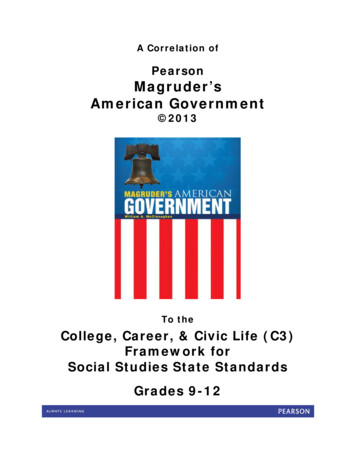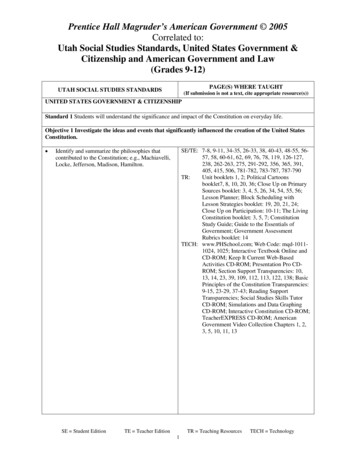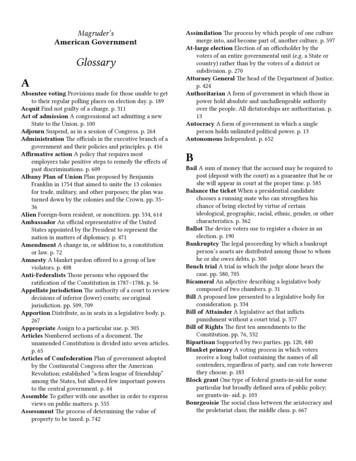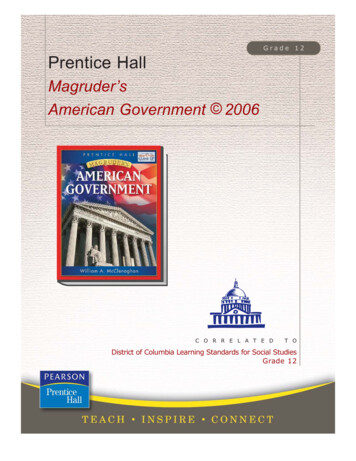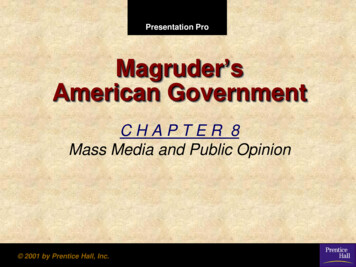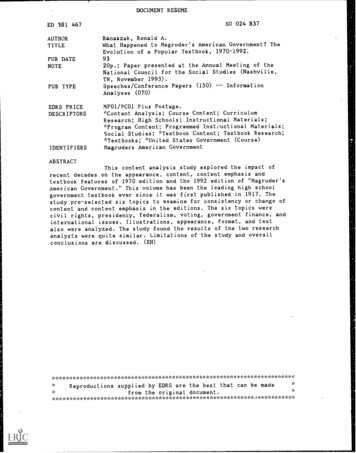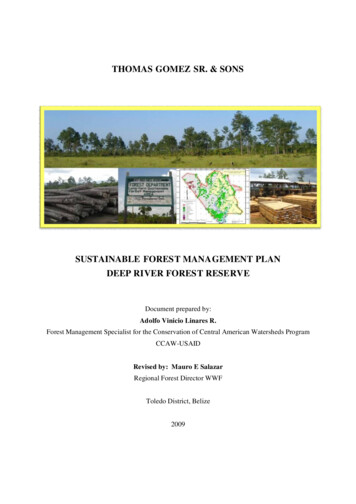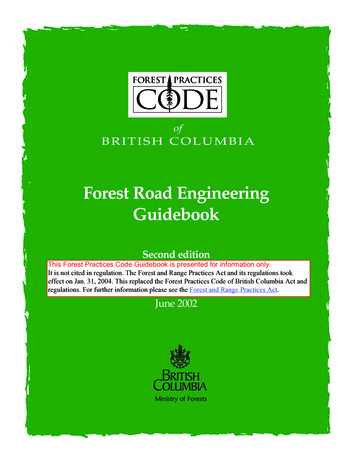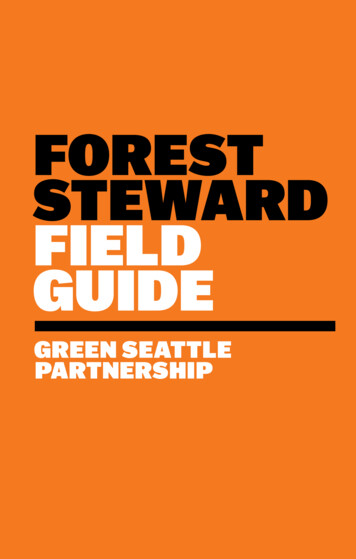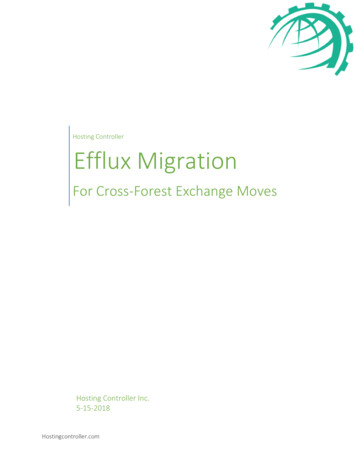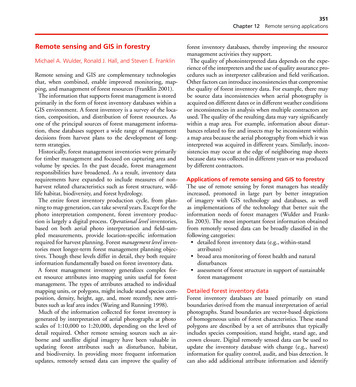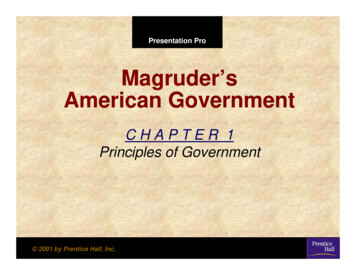
Transcription
Presentation ProMagruder’sAmerican GovernmentCHAPTER 1Principles of Government 2001 by Prentice Hall, Inc.
CHAPTER 1Principles of GovernmentSECTION 1Government and the StateSECTION 2Forms of GovernmentSECTION 3Basic Concepts of DemocracyGo ToSection:1 2 3Chapter 1
SECTION 1Government and the State How is government defined? What are the basic powers that everygovernment holds? What are the four defining characteristics ofthe state? How have we attempted to explain the originof the state? What is the purpose of government in theUnited States and other countries?Go ToSection:1 2 3Chapter 1, Section 1
What Is Government?Government is theinstitution through which asociety makes and enforcesits public policies.Go ToSection:1 2 3Chapter 1 Section 1
The StateThe state can be defined as having these fourcharacteristics:PopulationA state must have people,the number of which doesnot directly relate to itsexistence.SovereigntyEvery state is sovereign. Ithas supreme and absolutepower within its ownterritory and decides its ownforeign and domesticpolicies.Go ToSection:1 2 3TerritoryA state must be comprisedof land—territory with knownand recognized boundaries.GovernmentEvery state has agovernment — that is, it ispolitically organized.Chapter 1, Section 1
Origins of the StateThe Force Theory The force theory states that one person or a small group tookcontrol of an area and forced all within it to submit to thatperson’s or group’s rule.The Evolutionary Theory The evolutionary theory argues that the state evolved naturallyout of the early family.The Divine Right Theory The theory of divine right holds that God created the state andthat God gives those of royal birth a “divine right” to rule.The Social Contract Theory The social contract theory argues that the state arose out of avoluntary act of free people.Go ToSection:1 2 3Chapter 1, Section 1
The Purpose of GovernmentThe main purposes of government are described in thePreamble of the Constitution of the United States:“We the People of the United States, in Order to form amore perfect Union, establish Justice, insure domesticTranquility, provide for the common defence, promotethe general Welfare, and secure the Blessings of Libertyto ourselves and our Posterity, do ordain and establishthis Constitution for the United States of America.”Go ToSection:1 2 3Chapter 1, Section 1
Section 1 Review1. A government is(a) the institution through which a society makes and enforces its public policies.(b) a collection of people.(c) always democratic.(d) the organization representing farms and industries.2. A state has the following four characteristics:(a) population, territory, sovereignty, and government.(b) sovereignty, a perfect union, welfare, and territory.(c) people, places, force, and divine right.(d) justice, defense, liberty, and domestic tranquility.Want to connect to the Magruder’s link for this chapter? Click Here!Go ToSection:1 2 3Chapter 1, Section 1
SECTION 2Forms of Government How can we classify governments? How are systems of government defined interms of who can participate? How is power distributed within a state? How are governments defined by therelationship between the legislative andexecutive branches?Go ToSection:1 2 3Chapter 1, Section 2
Classifying GovernmentsGovernments can be classified by threedifferent standards:(1) Who can participate in the governing process.(2) The geographic distribution of the governmentalpower within the state.(3) The relationship between the legislative(lawmaking) and the executive (law-executing)branches of the government.Go ToSection:1 2 3Chapter 1, Section 2
Classification by Who Can ParticipateDemocracy In a democracy, supremepolitical authority rests withthe people. A direct democracy existswhere the will of the people istranslated into law directly bythe people themselves. In an indirect democracy, asmall group of persons,chosen by the people to actas their representatives,expresses the popular will.Go ToSection:1 2 3Dictatorship A dictatorship exists wherethose who rule cannot beheld responsible to the will ofthe people. An autocracy is agovernment in which asingle person holds unlimitedpolitical power. An oligarchy is agovernment in which thepower to rule is held by asmall, usually self-appointedelite.Chapter 1, Section 2
Classification by GeographicDistribution of PowerUnitary Government A unitary government hasall powers held by a single,central agency.Confederate Government A confederation is analliance of independentstates.Federal Government A federal government is one in which the powers ofgovernment are divided between a central government andseveral local governments. An authority superior to both the central and localgovernments makes this division of power on ageographic basis.Go ToSection:1 2 3Chapter 1, Section 2
Classification by the Relationship BetweenLegislative and Executive BranchesGo ToSection:1 2 3Chapter 1, Section 2
Forms of GovernmentGo ToSection:1 2 3Chapter 1, Section 2
Section 2 Review1. In a democracy,(a) independent states form an alliance.(b) supreme political authority rests with the people.(c) those who rule cannot be held responsible to the will of the people.(d) the rule by a few, select individuals regulates the will of the people.2. The United States government has the following characteristics:(a) confederate, parliamentary, and dictatorship.(b) unitary, presidential, and democracy.(c) federal, presidential, and democracy.(d) unitary, parliamentary, and dictatorship.Want to connect to the Magruder’s link for this section? Click Here!Go ToSection:1 2 3Chapter 1, Section 2
SECTION 3Basic Concepts of Democracy What are the foundations of democracy? What are the connections betweendemocracy and the free enterprise system? How has the Internet affected democracy?Go ToSection:1 2 3Chapter 1, Section 3
FoundationsThe American concept of democracy rests onthese basic notions:(1) A recognition of the fundamental worth and dignity of everyperson;(2) A respect for the equality of all persons;(3) A faith in majority rule and an insistence upon minorityrights;(4) An acceptance of the necessity of compromise; and(5) An insistence upon the widest possible degree ofindividual freedom.Go ToSection:1 2 3Chapter 1, Section 3
Democracy and the Free Enterprise System The free enterprise system is an economic systemcharacterized by private or corporate ownership ofcapital goods; investments that are determined byprivate decision rather than by state control; anddetermined in a free market. Decisions in a free enterprise system are determinedby the law of supply and demand. An economy in which private enterprise exists incombination with a considerable amount ofgovernment regulation and promotion is called amixed economy.Go ToSection:1 2 3Chapter 1, Section 3
Democracy and the Internet Democracy demands that the people bewidely informed about their government. Theoretically, the Internet makesknowledgeable participation in democraticprocess easier than ever before. However, all data on the World Wide Web isnot necessarily true, and the long-termeffects of the Internet on democracy has yetto be determined.Go ToSection:1 2 3Chapter 1, Section 3
Section 3 Review1. All of the following are basic notions found in the Americanconcept of democracy EXCEPT(a) a recognition of of the fundamental worth and dignity of every person.(b) a respect for the equality of all persons.(c) the rule of government by a single individual.(d) an acceptance of the necessity of compromise.2. In a free enterprise system, the means of capital are owned(a) by private and corporate entities.(b) by government agencies.(c) by only the agricultural sector.(d) equally by the collective citizenry.Want to connect to the Magruder’s link for this section? Click Here!Go ToSection:1 2 3Chapter 1, Section 3
Unitary Government A unitary government has all powers held by a single, central agency. Chapter 1, Section 2 Confederate Government A confederation is an alliance of independent states. Federal Government A federal governmentis one in which the powers of government are divided between a central government and several local governments.
